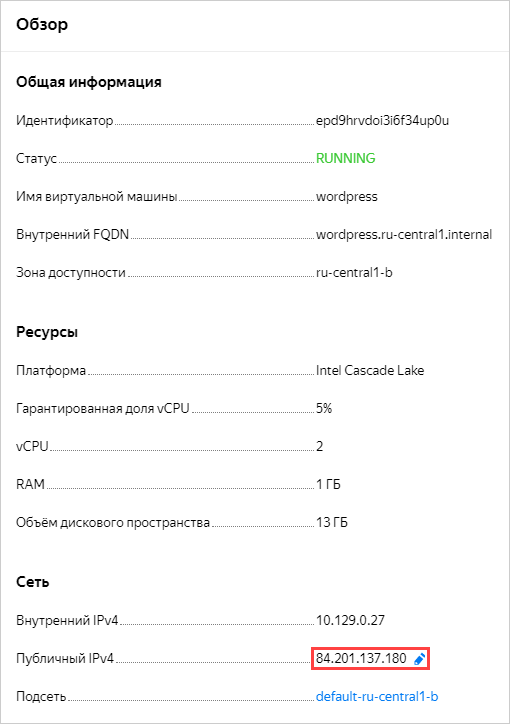Creating a WordPress website using Terraform
To create and set up a WordPress website using Terraform:
- Get your cloud ready.
- Create your infrastructure.
- Get credentials for authenticating in the web interface.
- Connect to the WordPress web interface.
If you no longer need the resources you created, delete them.
Get your cloud ready
Sign up for Yandex Cloud and create a billing account:
- Navigate to the management console
- On the Yandex Cloud Billing
ACTIVEorTRIAL_ACTIVEstatus. If you do not have a billing account, create one and link a cloud to it.
If you have an active billing account, you can navigate to the cloud page
Learn more about clouds and folders here.
Make sure the selected folder has a cloud network with a subnet in at least one availability zone. To do this, select VPC on the folder page. If the list contains a network, click its name to see the list of subnets. If the subnets or network you need are not listed, create them.
Required paid resources
The cost of maintaining a WordPress website includes:
- Fee for a continuously running VM (see Yandex Compute Cloud pricing).
- Fee for using a dynamic or static public IP address (see Yandex Virtual Private Cloud pricing).
- Fee for public DNS queries and DNS zones if using Yandex Cloud DNS (see Cloud DNS pricing).
Create an infrastructure
With Terraform
Terraform is distributed under the Business Source License
For more information about the provider resources, see the relevant documentation on the Terraform
To create an infrastructure using Terraform:
-
Install Terraform, get the authentication credentials, and specify the source for installing the Yandex Cloud provider (see Configure your provider, Step 1).
-
Prepare the infrastructure description files.
Ready-made archiveManually- Create a directory.
- Download the archive
- Unpack the archive to the directory. As a result, the
wordpress.tfconfiguration file should appear in it.
-
Create a directory.
-
Create a configuration file named
wordpress.tfin the folder:wordpress.tf
terraform { required_providers { yandex = { source = "yandex-cloud/yandex" version = ">= 0.47.0" } } } provider "yandex" { zone = "ru-central1-a" } resource "yandex_compute_image" "wordpress" { source_family = "wordpress" } resource "yandex_compute_disk" "boot-disk" { name = "bootvmdisk" type = "network-hdd" zone = "ru-central1-a" size = "20" image_id = yandex_compute_image.wordpress.id } resource "yandex_compute_instance" "vm-wordpress" { name = "wordpress" platform_id = "standard-v3" resources { core_fraction = 20 cores = 2 memory = 1 } boot_disk { disk_id = yandex_compute_disk.boot-disk.id } network_interface { subnet_id = yandex_vpc_subnet.subnet-1.id nat = true security_group_ids = ["${yandex_vpc_security_group.sg-1.id}"] } metadata = { ssh-keys = "<username>:<SSH_key_contents>" } } resource "yandex_vpc_security_group" "sg-1" { name = "wordpress" description = "Description for security group" network_id = yandex_vpc_network.network-1.id ingress { protocol = "TCP" description = "ext-http" v4_cidr_blocks = ["0.0.0.0/0"] port = 80 } ingress { protocol = "TCP" description = "ext-https" v4_cidr_blocks = ["0.0.0.0/0"] port = 443 } egress { protocol = "ANY" description = "any" v4_cidr_blocks = ["0.0.0.0/0"] } } resource "yandex_vpc_network" "network-1" { name = "network1" } resource "yandex_vpc_subnet" "subnet-1" { name = "subnet1" zone = "ru-central1-a" network_id = yandex_vpc_network.network-1.id v4_cidr_blocks = ["192.168.1.0/24"] } resource "yandex_dns_zone" "zone-1" { name = "example-zone-1" description = "Public zone" zone = "example.com." public = true } resource "yandex_dns_recordset" "rs-1" { zone_id = yandex_dns_zone.zone-1.id name = "example.com." ttl = 600 type = "A" data = ["${yandex_compute_instance.vm-wordpress.network_interface.0.nat_ip_address}"] } resource "yandex_dns_recordset" "rs-2" { zone_id = yandex_dns_zone.zone-1.id name = "www" ttl = 600 type = "CNAME" data = ["example.com"] }
Learn more about the properties of Terraform resources in the relevant provider guides:
-
Under
metadata, specify the metadata for creating a VM:<username>:<SSH_key_contents>. Regardless of the username specified, the key is assigned to the user set in the WordPress image configuration. Such users differ depending on the image. Learn more in Keys processed in public images Yandex Cloud. -
Create the resources:
-
In the terminal, go to the directory where you edited the configuration file.
-
Make sure the configuration file is correct using this command:
terraform validateIf the configuration is correct, you will get this message:
Success! The configuration is valid. -
Run this command:
terraform planYou will see a detailed list of resources. No changes will be made at this step. If the configuration contains any errors, Terraform will show them.
-
Apply the changes:
terraform apply -
Type
yesand press Enter to confirm the changes.
-
Get credentials for authenticating in the web interface
When creating a VM, an administrator account for the web interface is created automatically. To get authentication credentials:
-
Use SSH to connect to the VM you created:
ssh <username>@<VM_public_IP_address> -
Switch to the
rootaccount:sudo su -
Open the file for reading:
cat root/default_passwords.txt -
Copy the username and user password from the
WP_ADMIN_USERandWP_ADMIN_PASSWORDlines.
Connect to the WordPress web interface
To connect to the WordPress web interface, do the following:
-
In the management console

-
In your browser, open the WordPress admin panel using the domain name you configured or the VM's address:
http://<domain_name_or_VM_public_address>/wp-admin. -
Enter the username and password you saved earlier.
How to delete the resources you created
To stop paying for the resources you created:
-
Open the
wordpress.tffile and delete your infrastructure description from it. -
Apply the changes:
-
In the terminal, go to the directory where you edited the configuration file.
-
Make sure the configuration file is correct using this command:
terraform validateIf the configuration is correct, you will get this message:
Success! The configuration is valid. -
Run this command:
terraform planYou will see a detailed list of resources. No changes will be made at this step. If the configuration contains any errors, Terraform will show them.
-
Apply the changes:
terraform apply -
Type
yesand press Enter to confirm the changes.
-